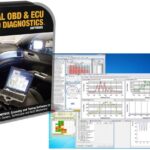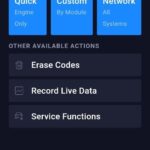Converting your OBD2 USDM H22a4 engine to utilize an OBD1 USDM H22a1 or H23a1 distributor is a modification favored by automotive enthusiasts for several key reasons. This guide will walk you through the process, outlining why this conversion is beneficial and how to execute it effectively.
Why Convert to an OBD1 Distributor on your H22 OBD2 Engine?
The primary motivations behind an OBD2 to OBD1 distributor conversion on H22 engines revolve around timing adjustability and aftermarket component compatibility. OBD2 H22 engines, specifically the H22a4, operate with ignition timing controlled entirely by the ECU. The stock OBD2 distributor lacks manual adjustability, limiting tuning capabilities.
Switching to an OBD1 distributor unlocks the ability to adjust base ignition timing. This is crucial for performance tuning, especially when modifications like aftermarket camshafts or increased compression ratios are introduced. Furthermore, OBD1 distributors are necessary to take full advantage of adjustable aftermarket cam gears. On H22a4 engines, attempting to adjust the exhaust cam gear with the OBD2 distributor will typically trigger a CYP (Cylinder Position Sensor) check engine light, hindering performance modifications.
Parts Needed for the Conversion
To perform this conversion, you will need the following components:
- OBD1 External Coil Distributor: Acquire an OBD1 distributor from a USDM H22a1 or H23a1 engine. These distributors utilize an 8-pin male connector.
- 8-Pin Female Connector and Pins: Obtain an 8-pin female connector and pins. These can often be sourced from junkyards, specifically from 92-95 Honda vehicles. Cut the connector with ample wire for soldering.
- 4-Pin Male Connector: A 4-pin male connector is also necessary. A common source for these is from 4-wire O2 sensors found on many vehicles.
Wiring Guide: OBD2 Distributor to OBD1 Distributor
The wiring process involves creating a harness to adapt the OBD2 engine harness to the OBD1 distributor. Utilize the CKP (Crankshaft Position Sensor) plug on the engine harness as your starting point. The following wiring diagram illustrates the connections:
| OBD2 Wire Color | OBD1 Wire Color | Function |
|---|---|---|
| Black | Blue/Yellow | CKP M (Crankshaft Position Sensor -) |
| Red | White/Blue | TDC M (Top Dead Center Sensor -) |
| White | WHITE | CYP M (Cylinder Position Sensor -) |
| Yellow | Blue/Green | CKP P (Crankshaft Position Sensor +) |
| Green | Orange/Blue | TDC P (Top Dead Center Sensor +) |
| Blue | Orange | CYP P (Cylinder Position Sensor +) |
| Yellow/Green | Yellow/Green | ICM (Ignition Control Module) |
| Green | Green | ICM (Ignition Control Module) |
Procedure:
- Carefully solder wires from the OBD2 engine harness (CKP plug) to the corresponding pins on the 8-pin female connector according to the wiring chart above.
- Connect the 8-pin female connector to your OBD1 distributor.
- Utilize the 4-pin male connector for any remaining connections as needed (typically for ICM).
Conclusion
Converting your H22 Obd2 Distributor to OBD1 provides valuable benefits for performance enthusiasts. Gaining manual timing adjustability and enabling the use of aftermarket adjustable cam gears opens up significant tuning potential for your H22 engine. By following this guide, you can successfully perform this conversion and unlock greater control over your engine’s performance.

